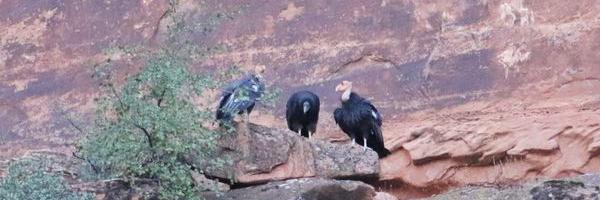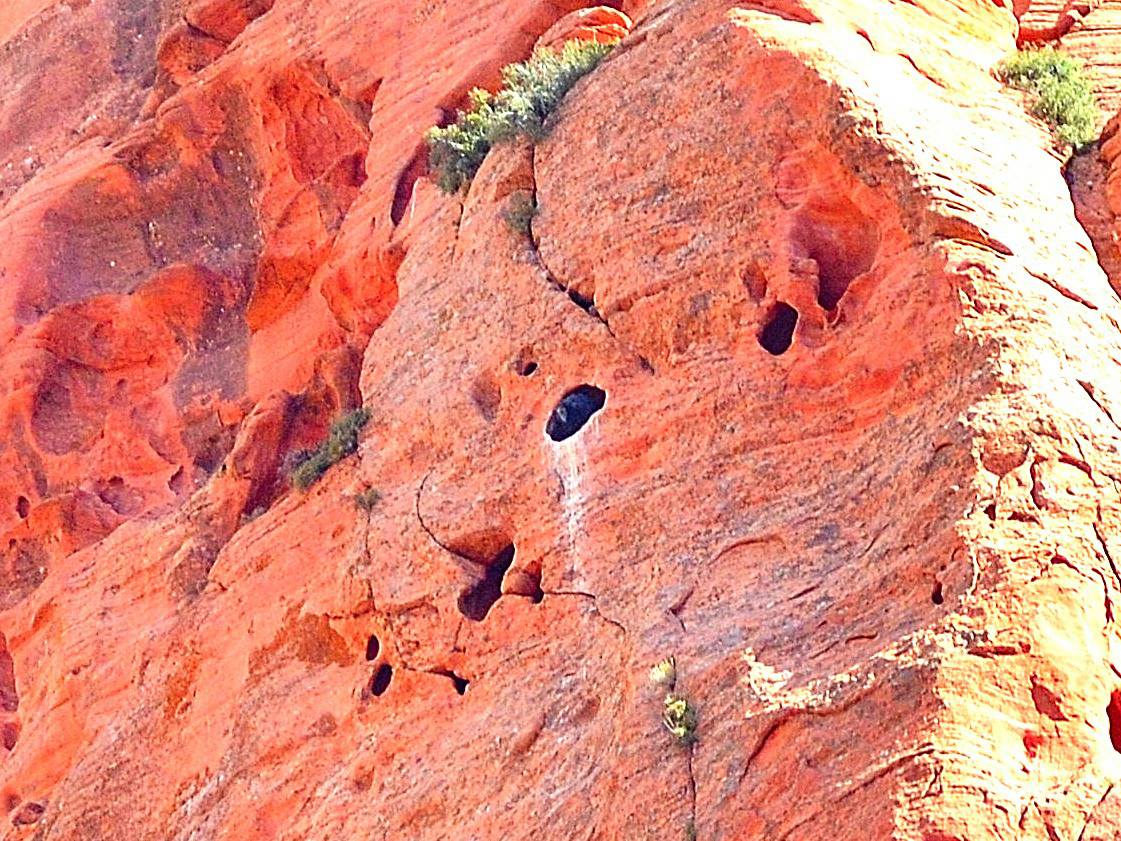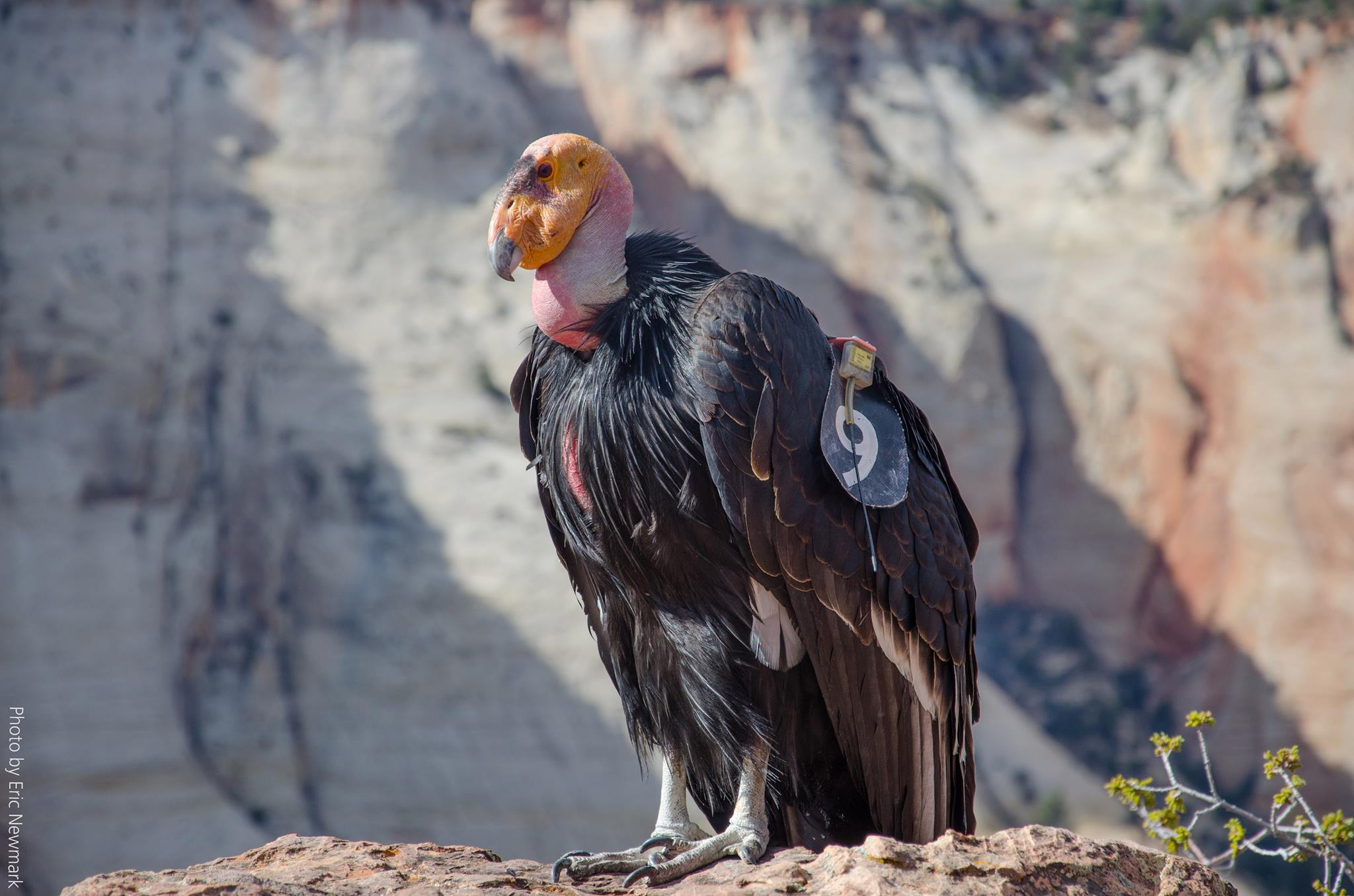National Park Service
Biologists throughout the southern-Utah and northern-Arizona range of the Critically Endangered California Condor are celebrating the news of two confirmed nests in southern Utah, each housing a quickly growing, fuzzy-gray nestling. This year’s young marks the first time biologists have observed multiple condor nestlings in Utah during the same breeding season.
The nests are both located on public lands, a testament to the value of these areas for wildlife conservation in addition to public recreation. The first nest confirmed by Zion National Park biologists, likely hatched around April 16 of this year, is located near Angel’s Landing, a popular hiking trail at Zion National Park. This nest was active in 2019 when California Condor nestling 1,000 (the studbook number assigned to identify the bird), affectionately known as 1K, successfully fledged, and is in use again this year by the same pair of adult condors. Condor 1K has spent the past two years learning how to be a condor with his parents (family pictured above). Now that he’s doing well and ready to be on his own, his parents returned to Zion to raise a new nestling. Not to be outdone by its older sibling, this year’s nestling also has a special studbook number, 1,111. California Condor 1,111 is expected to fledge the nest in mid-October of this year. Once fledged, 1,111 will spend approximately two years with its parents before it is ready to be independent.
Janice Stroud-Settles, Wildlife Program Manager at Zion National Park, says, "We were happy to learn the breeding pair at Zion chose to nest again in the cave near Angels Landing since the location lends exceptional condor viewing opportunities and facilitates an outstanding learning experience for visitors. The condor nestling was quickly confirmed thanks to the hard work of Zion's dedicated condor volunteers, who watch the nest activity almost daily while simultaneously sharing their knowledge and passion about condors and the condor recovery effort with park visitors."
The second nest that biologists were able to confirm hatched around May 11 and is located on Bureau of Land Management (BLM) land to the east of Zion National Park. The Peregrine Fund’s Condor Program Manager Tim Hauck said, “This is the first nesting attempt for the adult female, studbook number 801, and we were surprised to see the pairing. The female is only six years old, and while condors are capable of breeding at five to six years of age, on average they are not successful until they reach eight years of age.”
Another surprise came when the team realized the male was a 10-year old condor, studbook number 605. He was single going into the breeding season and the team wasn’t sure he had found a mate. The biologists had been watching both birds for some time when condor field biologist, Erin Brannon, caught them in the act of performing a nest exchange. Later, another biologist, Jeff Grayum, was able to confirm the presence of a nestling through his scope. “We were lucky that this pair nested in a place that had a good vantage point,” said Hauck. “It can be really difficult to see inside a condor nest since they are typically in caves, high up on the side of cliffs. Fortunately, at this particular location, we had a good eye-level vantage point from which we could see into the nest and identify the nestling using our spotting scope.”
Keith Day, Wildlife Biologist with the Utah Division of Wildlife Resources, is excited about what this means for the future, "We are encouraged to see condors making use of the good nesting habitats here in southwest Utah, which just increases the chances for recovery success."
The adult birds at Zion National Park are studbook numbers 409 and 523. The female, 409, was hatched at the San Diego Zoo’s breeding program. The male, 523, and both birds from the pair on BLM land were hatched at The Peregrine Fund’s World Center for Birds of Prey in Boise, Idaho.
These new nestlings are exciting for Hauck and his team. “We are seeing more consistent and successful breeding in southern Utah than ever before. The habitat is ideal for the birds and they seem to know it. We reached a milestone number of more than 100 wild birds in northern Arizona last summer. It’s exciting to know that some of those birds are choosing to expand into Utah and we hope that the Utah population continues to grow.”
Brandon Boshell of the Bureau of Land Management adds, "As the BLM's Vermilion Cliffs National Monument manager, I consider it a privilege that the release site for the Arizona/Utah California condor population is located within the spectacular Vermilion Cliffs. We work with other units, agencies, and organizations in this collaborative effort. It is exciting to hear the news this year of nestlings in Utah. There have been so many individuals and organizations who have worked tirelessly over the past few decades to save this incredible species from the brink of extinction. We have so far to go with many challenges to confront, but with the resiliency of the bird, the efforts of incredible individuals and organizations, let's celebrate this accomplishment and how the Arizona/Utah population is expanding and growing."
The historical California Condor population declined to just 22 individuals in the 1980s when the greater California Condor Recovery Program was initiated to save the species from extinction. As of July 2021 there are more than 100 condors in the wild in the rugged canyon country of northern Arizona and southern Utah and the total world population of endangered California Condors numbers more than 500 individuals, with more than half flying the skies of Arizona, Utah, California, and Mexico.
The Arizona-Utah recovery effort is a cooperative program by federal, state, and private partners, including The Peregrine Fund, the Bureau of Land Management in Utah, the Bureau of Land Management’s Vermilion Cliffs National Monument, Arizona Game and Fish Department, U.S. Fish and Wildlife Service, Grand Canyon and Zion national parks, Utah Division of Wildlife Resources, and Kaibab and Dixie national forests among many other supporting groups and individuals.
Learn more:
- Learn more about our California Condor recovery project.
- Watch a segment on CBS This Morning featuring our California Condor project!









